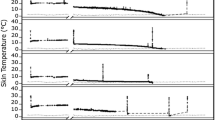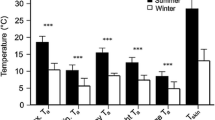Abstract
For temperate endotherms (i.e., mammals and birds) energy costs are highest during winter but food availability is lowest and many mammals depend on hibernation as a result. Hibernation is made up of energy-saving torpor bouts [periods of controlled reduction in body temperature (T b)], which are interrupted by brief periodic arousals to normothermic T b. What triggers these arousals in free-ranging hibernators is not well understood. Some temperate bats with intermittent access to flying insects during winter synchronize arousals with sunset, which suggests that, in some species, feeding opportunities influence arousal timing. We tested whether hibernating bats from a cold climate without access to food during winter also maintain a circadian rhythm for arousals or whether cues from conspecifics in the same cluster are more important. We used temperature telemetry to monitor skin temperature (T sk) of free-ranging little brown bats (Myotis lucifugus) hibernating in central Manitoba, Canada, where temperatures from 22 October to 22 March were too cold for flying insects. We found no evidence bats synchronized arousals with photoperiod but they did arouse synchronously with other bats in the same cluster. Thus, in the northern part of their range where flying insects are almost never available during winter, little brown bats exhibit no circadian pattern to arousals. Warming synchronously with others could reduce the energetic costs of arousal for individuals or could reflect disturbance of torpid bats by cluster-mates.



Similar content being viewed by others
References
Aldridge H, Brigham RM (1988) Load carrying and maneuverability in an insectivorous bat: a test of the 5% “rule” of radio-telemetry. J Mammal 69:379–382
Audet D, Thomas DW (1996) Evaluation of the accuracy of body temperature measurement using external radiotransmitters. Can J Zool 74:1778–1781
Barclay RMR, Kalcounis MC, Crampton LH, Stefan C, Vonhof MJ, Wilkinson L, Brigham RM (1996) Can external radiotransmitters be used to assess body temperature and torpor in bats? J Mammal 77:1102–1106
Blehert DS, Hicks AG, Behr M, Meteyer CU, Berlowski-Zier BM, Buckles EL, Coleman JTH, Darling SR, Gargas A, Niver R, Okoniewski JC, Rudd RJ, Stone WB (2009) Bat white-nose syndrome: an emerging fungal pathogen? Science 323:227
Boyles JG, Brack JV (2009) Modeling survival rates of hibernating mammals with individual-based models of energy expenditure. J Mammal 90:9–16
Boyles JG, Willis CKR (2010) Could localized warm areas in cold caves reduce mortality of hibernating bats affected by white-nose syndrome? Front Ecol Environ 8:92–98
Boyles JG, Storm JJ, Brack JV (2008) Thermal benefits of clustering during hibernation—a field test of competing hypotheses on Myotis sodalis. Funct Ecol 22:632–6369
Davis WH, Hitchcock HB (1965) Biology and migration of the bat, Myotis lucifugus, in New England. J Mammal 46:296–313
Geiser F (2004) Metabolic rate and body temperature reduction during hibernation and daily torpor. Annu Rev Physiol 66:239–274
Grahn DA, Miller JD, Houng VS, Heller HC (1994) Persistence of circadian rhythmicity in hibernating ground squirrels. Am J Physiol Regul Integr Comp Physiol 266:R1251–R1258
Hope PR, Jones G (2012) Warming up for dinner: torpor and arousal in hibernating Natterer’s bats (Myotis nattereri) studied by radio telemetry. J Comp Physiol B 182:569–578
Humphries MM, Thomas DW, Kramer DL (2003) The role of energy availability in mammalian hibernation: a cost–benefit approach. Physiol Biochem Zool 76:165–179
Jonasson KA, Willis CKR (2011) Changes in body condition of hibernating bats support the thrifty female hypothesis and predict consequences for populations with white-nose syndrome. PLoS One 6:e21061
Jonasson KA, Willis CKR (2012) Hibernation energetics of little brown bats. J Exp Biol 215:2141–2149
Jones G, Duvergé PL, Ransome RD (1995) Conservation biology of an endangered species: field studies of greater horseshoe bats. Symp Zool Soc Lond 67:309–324
Lorch JM, Meteyer CU, Behr MJ, Boyles JG, Cryan PM et al (2011) Experimental infection of bats with Geomyces destructans causes white-nose syndrome. Nature 480:376–378
Luis AD, Hudson PJ (2006) Hibernation patterns in mammals: a role for bacterial growth? Funct Ecol 20:471–477
Malan A (2010) Is the torpor-arousal cycle of hibernation controlled by a nontemperature-compensated circadian clock? J Biol Rhythms 25:166–175
Moore MS, Reichard JD, Murtha TD, Zahedi B, Fallier RM, Kunz TH (2011) Specific alterations in complement protein activity of little brown myotis (Myotis lucifugus) hibernating in white-nose syndrome affected sites. PLoS One 6:e27430
National Climate Data and Information Archive. Environment Canada. www.climate.weatheroffice.gc.ca. Accessed 9 October 2012
Park KJ, Jones G, Ransome RD (2000) Torpor, arousal and activity of hibernating greater horseshoe bats (Rhinolophus ferrumequinum). Funct Ecol 14:580–588
Prendergast BJ, Freeman DA, Zucker I, Nelson RJ (2002) Periodic arousal from hibernation is necessary for initiation of immune responses in ground squirrels. Am J Physiol 282:1054–1062
Racey PA, Swift SM (1981) Variations in gestation length in a colony of pipistrelle bats (Pipistrellus pipistrellus) from year to year. J Reprod Fertil 6:123–129
R Development Core Team (2009) R: A language and environment for statistical computing R Foundation for Statistical Computing, Vienna, Austria ISBN 3- 900051-07-0, URL: http://www.R-project.org
Reeder DM, Frank CL, Turner GG, Meteyer CU, Kurta A et al (2012) Frequent arousal from hibernation linked to severity of infection and mortality in bats with whitenose syndrome. PLoS One 7:e38920
Ruby NF, Dark J, Burns DE, Heller HC, Zucker I (2002) The suprachiasmatic nucleus is essential for circadian body temperature rhythms in hibernating ground squirrels. J Neurosci 221:357–364
Ruf T, Arnold W (2000) Mechanisms of social thermoregulation in hibernating alpine marmots (Marmota marmota). In: Heldmaier G, Klingenspor M (eds) Life in the cold: eleventh international hibernation symposium. Springer, Berlin, pp 81–94
Stawski C, Geiser F (2009) Fat and fed: frequent use of summer torpor in a subtropical bat. Naturwissenschaften 97:29–35
Thomas DW (1993) Lack of evidence for a biological alarm clock in bats (Myotis spp.) hibernating under natural conditions. Can J Zool 71:1–3
Thomas DW, Cloutier D (1992) Evaporative water loss by hibernating little brown bats, Myotis lucifugus. Physiol Zool 65:443–456
Thomas DW, Geiser F (1997) Periodic arousals in hibernating mammals is evaporative water loss involved? Funct Ecol 11:585–591
Thomas DW, Fenton BM, Barclay RMR (1979) Social behavior of the little brown bat, Myotis lucifugus: I. mating behavior. Behav Ecol Sociobiol 6:129–136
Thomas DW, Dorais M, Bergeron JM (1990) Winter energy budgets and cost of arousals for hibernating little brown bats, Myotis lucifugus. J Mammal 71:475–479
Wang LCH (1978) Energetic and field aspects of mammalian torpor: the Richardson’s ground squirrels. In: Wang LCH, Hudson JW (eds) Strategies in cold. Academic Press, New York, pp 109–145
Warnecke L, Turner JM, Bollinger TK, Lorch JM, Misra V, Cryan PM, Wibbelt G, Blehert DS, Willis CKR (2012) Inoculation of a North American bat with European Geomyces destructans supports the novel pathogen hypothesis for the origin of white-nose syndrome. Proc Natl Acad Sci USA 109:6999–7003
Wilkinson GS, South JM (2002) Life history, ecology and longevity in bats. Aging Cell 1:124–131
Willis CKR, Brigham RM (2003) Defining torpor in free-ranging bats: experimental evaluation of external temperature-sensitive radiotransmitters and the concept of active temperature. J Comp Physiol B 173:379–389
Willis CKR, Jameson J, Faure PA, Boyles JG, Brack JV, Cervone TH (2009) Thermocron iButton and iBBat temperature dataloggers emit ultrasound. J Comp Physiol B 179:867–874
Acknowledgments
We thank Dylan Baloun, Ally Menzies, Felix Martinez-Nuñez, Chonny Sayapheth and Adriana Suarez for help with fieldwork and Manitoba Conservation for lodging in the field. This research was supported by Grants to CKRW from the Natural Sciences and Engineering Research Council (Canada), the Canada Foundation for Innovation, the Manitoba Research and Innovation Fund, The Manitoba Hydro Forest Enhancement Program and The University of Winnipeg Chancellor’s Research Chair in Wildlife Health.
Author information
Authors and Affiliations
Corresponding author
Additional information
Communicated by G. Heldmaier.
Rights and permissions
About this article
Cite this article
Czenze, Z.J., Park, A.D. & Willis, C.K.R. Staying cold through dinner: cold-climate bats rewarm with conspecifics but not sunset during hibernation. J Comp Physiol B 183, 859–866 (2013). https://doi.org/10.1007/s00360-013-0753-4
Received:
Revised:
Accepted:
Published:
Issue Date:
DOI: https://doi.org/10.1007/s00360-013-0753-4




